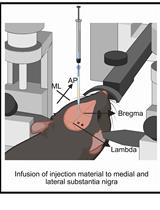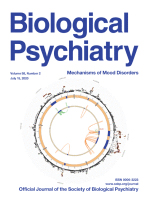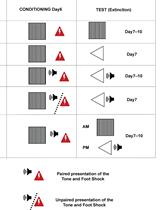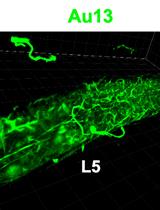- EN - English
- CN - 中文
Activity-based Anorexia for Modeling Vulnerability and Resilience in Mice
基于活动的厌食症小鼠脆弱性和恢复力模型的建立
发布: 2021年05月05日第11卷第9期 DOI: 10.21769/BioProtoc.4009 浏览次数: 3335
评审: Arnau Busquets-GarciaMario ValentinoAnonymous reviewer(s)

相关实验方案

基于 rAAV-α-Syn 与 α-Syn 预成纤维共同构建的帕金森病一体化小鼠模型
Santhosh Kumar Subramanya [...] Poonam Thakur
2025年12月05日 1393 阅读
Abstract
Activity-based anorexia (ABA) is a widely used rodent model of anorexia nervosa. It involves combining limited access to food with unlimited access to a running wheel, leading to a paradoxical decrease in food intake, hyperactivity, and life-threatening weight loss. Although initially characterized in rats, ABA has been tested in mice with results that vary based on strain, sex, age, the amount of time food is available, and the number of days of food restriction. Here, we present our ABA protocol for modeling both vulnerability and resilience to diet and exercise in C57BL/6 female mice. While vulnerable mice exhibit the expected increase in running, reduction in food intake, and excessive weight loss, resilient mice exhibit an adaptive increase in food intake, decrease in total wheel running, and weight stabilization. In contrast to previous ABA studies in which resilience is defined by the relative rate of weight loss, our protocol leads to a resilient phenotype that more closely resembles the maintenance of a stable bodyweight exhibited by most humans who diet and exercise without developing anorexia nervosa. This protocol will be useful for future studies aimed at identifying the physiological and neural adaptations underlying both resilience and vulnerability to this eating disorder.
Keywords: Anorexia nervosa (神经性厌食症)Background
In the 1950s, Hall and Hanford first reported that rats placed on a restricted feeding schedule and given access to a running wheel exhibit a paradoxical increase in running and a decrease in food intake, leading to extreme weight loss (Hall et al., 1953; Hall and Hanford, 1954). The extent to which these responses are life-threatening was established in a later study, in which all the tested rats effectively ran themselves to death (Routtenberg and Kuznesof, 1967). Collectively, these findings formed the basis for the most commonly used animal model of anorexia nervosa, activity-based anorexia (ABA). ABA shares several characteristics with the human disorder, including extreme weight loss, increased voluntary physical activity, self-starvation, loss of estrus (Dixon et al., 2003), and greater vulnerability during adolescence (Woods and Routtenberg, 1971). As an animal model, it enables examination of how caloric restriction in combination with physical activity leads to neural and endocrine adaptations that may contribute to the development of the disorder. While most ABA studies have used rats, an increasing number are using mice, with results that vary based on strain, sex, age, the amount of time food is available, the number of days of food restriction, and how wheel-running is analyzed (Gelegen et al., 2007 and 2008; Klenotich et al., 2012). Given the number of variables affecting susceptibility to ABA, consistency across studies with respect to the parameters used and how the data are analyzed would enhance utility of the model.
A critical question in the field has been what factors promote vulnerability or resilience to anorexia nervosa. This has been difficult to model in ABA since most studies restrict food for 5 days or less, during which all animals show significant weight loss. Weight loss is particularly rapid in adolescent animals. Some investigators categorize animals as ‘vulnerable’ or ‘resilient’ based on how quickly they lose weight during this time period, either by evaluating individual differences within a group (Barbarich-Marsteller et al., 2013; Chowdhury et al., 2013) or by making strain comparisons (Gelegen et al., 2007). However, until recently no implementation of ABA has demonstrated a truly resilient phenotype, defined as adaptation and weight stabilization in the face of food restriction and exercise. We recently published our ABA study in which roughly half of the animals exhibit resilience by decreasing total running, increasing food intake, and reaching a stable bodyweight (Beeler et al., 2020). The other half of the animals are vulnerable to ABA, as demonstrated by increased wheel running, a failure to adapt food intake to increased energy expenditure, and excessive weight loss. Notably, we also detected vulnerability and resilience in food-restricted mice housed with a locked running wheel; although, wheel running does appear to accelerate weight loss. Here, we present the detailed protocol that we used to obtain distinct vulnerable and resilient phenotypes, which involves the use of young adult C57/BL6 female mice instead of adolescent mice, extending the number of days of food restriction from 5 to 10, and conducting a thorough analysis of individual differences.
This protocol will be useful for future studies aimed at characterizing vulnerability and resilience to anorexia nervosa. By generating both phenotypes, this protocol allows studies to examine the physiological, neural, and endocrine factors that differentiate the two, facilitating greater insight into the biological basis of this eating disorder. This protocol also provides an opportunity to evaluate the extent to which interventions decrease vulnerability and favor adaptation and resilience.
Materials and Reagents
Mouse cages: 19.56 cm (width) × 30.91 cm (length) × 14.94 cm (height) (Model #9, Thoren Caging Systems, Inc., Hazleton, PA)
Wire bar lids (WBL7115SMD-AMG, Allentown Inc., Allentown, NJ)
Beta Chip Hardwood bedding (Northeastern Products, WF Fisher and Sons, Somerville, NJ)
Prolab IsoPro rodent diet (WF Fisher & Son, Inc., catalog number: LD5P75) stored at 4°C
Mouse igloo (Bio-Serv, catalog number: K3327)
Clorox Fresh Scent Disinfecting Wipes
Paper towels
8-week-old female C57BL/6N mice (Taconic Biosciences, Germantown, NY)
Equipment
Low-profile wireless running wheels for mice (Med Associates, catalog number: ENV 047)
USB interface hub for wireless running wheels (Med Associates, catalog number: DIG-807)
PC computer
Green features turned ‘off’ so that the display does not go off, the PC does not hibernate or go to sleep, and the hard drive does not turn off
Analytical balance scale (1 mg)
Compact scale (0.1 g) (Fisher Scientific, catalog number: 0191933)
White noise machine (Marpac Dohm-Dual Speed)
Digital thermometer (VWR, catalog number: 35519-047)
External lights (GE Fluorescent Under Cabinet Light Fixtures)
Light timer (Indoor 24 Hour Mechanical Outlet Timer with 2-Outlets)
Red headlamp (Energizer headlamp with one red LED)
Software
Wheel Manager (SOF-860, Med Associates, Inc., St. Albans, VT)
Procedure
文章信息
版权信息
© 2021 The Authors; exclusive licensee Bio-protocol LLC.
如何引用
Beeler, J. A. and Burghardt, N. S. (2021). Activity-based Anorexia for Modeling Vulnerability and Resilience in Mice. Bio-protocol 11(9): e4009. DOI: 10.21769/BioProtoc.4009.
分类
神经科学 > 神经系统疾病 > 动物模型
您对这篇实验方法有问题吗?
在此处发布您的问题,我们将邀请本文作者来回答。同时,我们会将您的问题发布到Bio-protocol Exchange,以便寻求社区成员的帮助。
Share
Bluesky
X
Copy link










